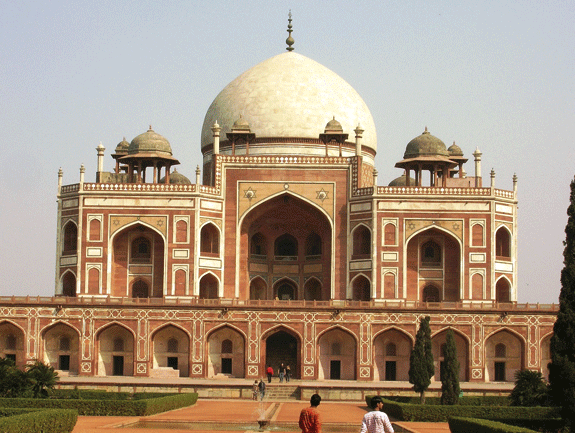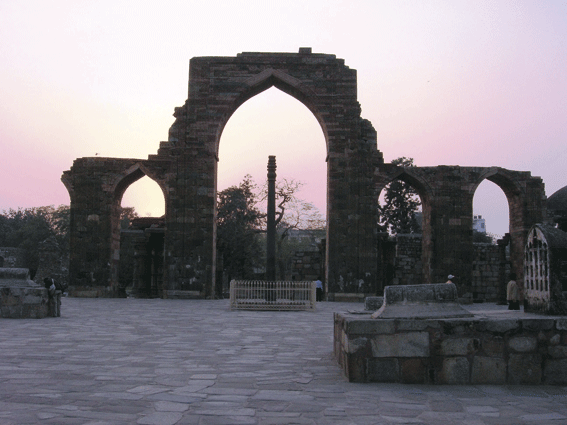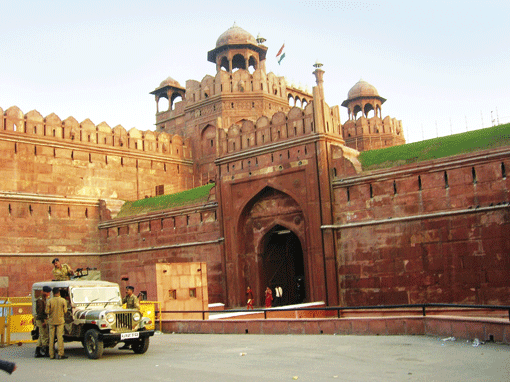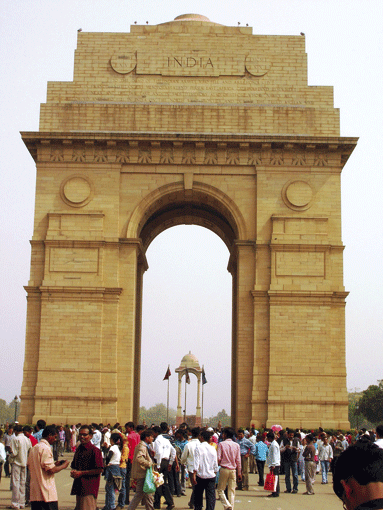
Travel
Delhi
The Soul of India

If your idea of a holiday is to spend time in spic and span city, with café-lined, cobbled streets and
no traffic jams, then stop right here. But if you want to feel the pulse of a metropolis that
reflects the essence of a 5,000-year-old nation, then read on.
By: Rufaida Javid *
The first thing that a new visitor to any Indian city will notice is the sheer number of people around. You feel you are in a sea of humanity. And Delhi, with a population of 16 million, is certainly no exception.
Delhi is, in many ways, like those other great cities of the East - Istanbul and Cairo - which leave any visitor overwhelmed by their combination of history, culture, political significance, and chaos. To truly appreciate the Indian capital, you need to stay here for a week or at least five days.
Delhi was the seat of power of the glorious Muslim dynasties that ruled India for more than 700 years, and they have left their indelible footprint on the city, not only in the form of their enduring architectural masterpieces but also through a culinary legacy that rivals the best in the world.
Culture
Today, the most pervasive influence in Delhi is that of the Punjabis, most of whose ancestors migrated from present-day Pakistan during the Partition in 1947. They are the richest and largest community in the city. You are as likely to hear Punjabi being spoken in Delhi as Hindi.
The Old City is home to Delhi’s shrinking Muslim community, the descendents of the rulers who built the city. Many migrated to Pakistan during the Partition.
Politics is central to Delhi life. Wherever you go, you are surrounded by centers of power, including the magnificent Parliament building and the majestic Rashtrapati Bhavan (the presidential palace). On any given day, you are likely to come across convoys of official cars, sirens blaring, racing away to South Block. Most foreign embassies are located in and around the posh Chanakyapuri area. Delhi being the capital of the country, governments of all states in India have their own guest houses in the city, where officials from the state stay during their visits.
Things To See
A good way of spending your first day in Delhi is to book a day-long city tour through one of the numerous tour operators. Ask your hotel for details. The guided tours will take you to all the main attractions of the city, and you can then come back to those you most liked, and spend quality time there. Also visit the Government of India Tourist Office, where you can get reliable information and good quality tourist brochures free of cost (Address: 88 Janpath, Connaught Place. Tel:23320005, 23320008, 23320109, 23320266).
The Qutub Minar is to Delhi what the Eiffel Tower is to Paris - the most famous structure in town. Construction of the minar was started after 1206 AD, when Qutub-ud-Din Aibak founded the Slave Dynasty, and completed in 1220. The magnificent tower stands 72.5 meters tall. It is a UNESCO World Heritage Site. You will also see Delhi’s first mosque, the Quwwat Al Islam Masjid, within the Qutub Minar complex.
While there, also check out the intriguing iron pillar. Local legend has it that if your arms are long enough to enable you to circle the pillar, then all your wishes will be met. So give it a try - you never know!
Your next stop should be the Red Fort, the greatest fort in India and certainly one of the grandest in the world. This perfect structure was built in 1648 by the fifth Mughal emperor Shah Jahan (he of Taj Mahal fame). It was constructed in red sandstone (hence the name) and served as Shah Jahan’s seat of government. The two main buildings within the fort are the Diwan-e-Aa’am (Hall of Public Audience) and the Diwan-e-Khaas (Hall of Private Audience), which is set in pure white marble and was the place where the emperor received his most important guests.
Opposite the Red Fort you will see India’s largest and most important mosque, the Jama Masjid. Another one of Shah Jahan’s architectural masterpieces, it can accommodate up to 30,000 worshippers. The view of the Old City from the mosque’s terrace is memorable.
Near the Nizamuddin railway station, you will come across another UNESCO World Heritage Site. Humayun’s Tomb is my favourite monument in Delhi. It was commissioned in 1562 by the widow of the second Mughal emperor. The beautiful structure is said to be the inspiration behind the Taj Mahal in Agra.
Humayun met an unfortunate end in March, 1556, at the age of 48, sustaining head injuries after falling down the stairs of his library while rushing for Magrib prayers.
Said to be inspired by Sydney’s famous Opera House, the Lotus Temple in Delhi is certainly worth a visit. It is, literally, shaped like a lotus.
A good way to spend the late afternoon and evening is to loiter around the majestic India Gate, one of the most recognizable buildings in the capital. Built as a memorial to the Indian soldiers who died in World War I, it has a burning “eternal flame” . Many Delhi families come to the pleasant lawns next of the monument to while away their evenings, making this a good spot for that most essential of tourist activity: people watching.
Getting Around
Life in Delhi changed for the better with the introduction of the slick, new metro, something a city the size of Delhi should have had long before. But, like they say, better late than never.
Though still limited in its scope, the metro rail takes you to most of the important tourist spots. This, then, is the best way around town.
Delhi’s autorickshaw and taxi drivers, infamous all over India for being rude and for demanding exorbitant fares, have suddenly mellowed down. I could not believe this transformation, as I had bitter memories of past trips. So what has bought about this change? Well it is the metro, again. More and more people are taking the metro, and business is not too good for the autos and taxis.
However, you will need to take autos and taxis at some point in your trip. Negotiate the fare in advance, always. Delhi also has a well-connected bus system, but it is eminently avoidable. In the Old City, around the Jama Masjid, streets are so congested that best way to get around is on a cycle-rickshaw.
Traffic
You will have to see it to believe the kind of mess the Delhi traffic is in. You will see the most basic rules of driving, which you have held dear, being violated here with impunity. Lane discipline is unheard of and rash driving the norm. A word of caution: be very careful while crossing the streets.
Shopping And Eating
There are two things Delhities will admit are good in the city: shopping and eating. The best bargains in town are to be had in Karol Bagh and Connaught Place. Everything from good leather jackets (for about SR100) to a fake Rolex can be bought here. You must spare at least one day to sample the city’s shopping delights.
Wherever you are in Delhi, you are never far away from your next meal. From roadside eateries to high-end restaurants serving the best international cuisine, the city is a foodie’s delight. For good old Mughlai food, I always head to my favorite restaurant in the Old City - Karim’s. Set up in 1913, it serves the world’s best kababs and is still run by the same family. In fact, they have branched out into the Middle East too, with a restaurant in Dubai.
Visas
Citizens of most countries need a visa to travel to India. Contact the Indian embassy in Riyadh or the Indian consulate in Jeddah for details.
* Rufaida Javid is a freelance writer based in Dubai.